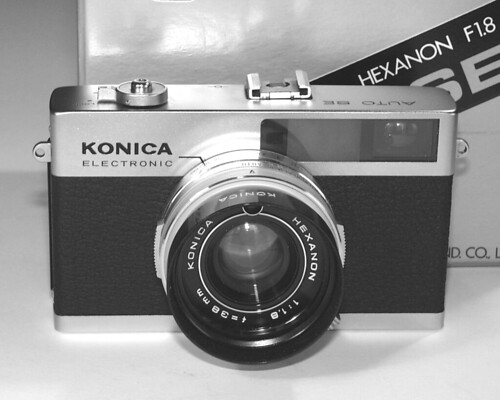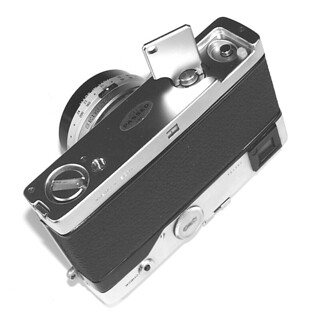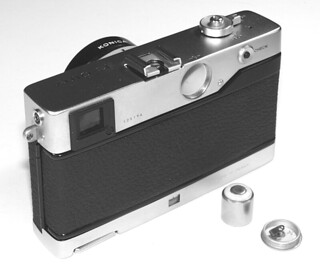Konica Auto SE Electronic

|
| Konica Auto SE Electronic image by Alan Myers (Image rights) |
Introduced in 1966, the Konica Auto SE Electronic is one of the last full size Konica 35mm rangefinder cameras, but it bears little resemblance to the earlier Auto S models. It's an entirely new camera — enough so that it might not be appropriate to list it along with the rest of the Auto S series — with completely different chassis and body, a unique lens and shutter, AE-program exposure mode only, and an unusual mechanical automatic film advance mechanism. The Auto SE is also the first Konica rangefinder to be fitted with a standard hot shoe. (The IIIM of 1959 had a hot shoe, too... but it was of a non-standard type that required a specially dedicated flash. The Konica Auto S1.6 was the second of the company's rangefinders to include a hot shoe, a short time later.)
The 38mm f/1.8 Hexanon lens (6 elements in 4 groups) sits in a Seiko SE leaf shutter. There is a built-in, slide out lens hood and 49mm filters can be fitted. Shutter speeds are unmarked and unknown, since it's a program AE camera. There is an AUTO setting on top of the lens, and adjacent to that a Guide Number distance scale (in meters and feet) for use with electronic flash. On the bottom of the lens is a means of setting the film speed ASA/ISO (25-400) and DIN. But that's the extent of exposure-related input from the user. Everything else is fully automatic.
Most Konica cameras are quite well made, durable, highly functional and cleverly designed. However, in hand the Auto SE seems even more premium than most. Perhaps in part this is because of the very clean and streamlined appearance.
While not unheard of on other manufacturers' cameras, the mechanical automatic film advance feature of the Auto SE is an unusual and interesting feature. There is a fold-out key on the bottom of the camera used to wind up a spring mechanism that drives the film advance. Once wound, it's good for 6 to 10 exposures, after which it will need to be wound again. Hidden under the wind key is a film rewind release button, used in conjunction with the film rewind knob recessed into the other end of the bottom of the camera.
As a result, the top of the camera only has the hot shoe and the shutter release button with a rotating off/on switch collar immediately around it. Rotated fully clockwise, that collar also provides a self-timer. There's a battery check button on the rear and a standard PC flash sync socket provided on the left side of the camera. A little window in the center rear of the bottom cover displays an exposure counter.
The viewfinder is large and bright, and provides automatic parallax error and field correction. The brightline framing adjusts as the lens is focused. It's also an unusually close focusing lens: 2 feet approx.
Unfortunately, due to the CdS-type metering and auto-exposure-only nature of this camera, it's completely battery dependent and it uses a somewhat less common PX1 size, now virtually impossible to find mercury cell battery. I'm unaware of any ready-made adapters for this size battery, but have been successful fashioning an adapter myself that allowed using a silver oxide SR44 in another camera that called for PX1. The different voltage will skew the meter and effect exposure accuracy. It might be possible to compensate for this with an adjusted ASA/ISO setting. Or the camera could be calibrated for the higher voltage by a professional repair technician.

|
| Bottom view, showing key wind for film advance mechanism and film rewind knobs image by Alan Myers (Image rights) |

|
| Rear view showing battery compartment and PX1 battery image by Alan Myers (Image rights) |
(Note: It's possible this camera's lens is a precursor for the well regarded Hexanon AR 40mm f/1.8 "pancake" lens offered years later among the line of interchangeable lenses for Konica SLR. The pancake Hexanon actually measures a true 38mm focal length, per Popular Photography testing at the time, same as the lens on the Auto SE. Unfortunately, there's no record or means of checking this, so it's just a side note and a bit of conjecture.)
The Konica Electron of 1969 is to some extent an update of the Auto SE, except it takes a step backward with only a cold shoe and a more standard manual film advance mechanism. The Electron does provide a socket to utilize Flash Cubes.